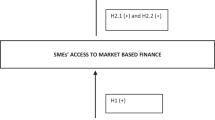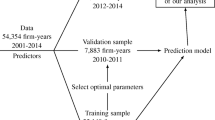Abstract
This paper provides empirical confirmation for Petersen and Rajan’s (J Finance 57:2533–2570, 2002) widely accepted conjecture that information technology was the primary driver of the observed increase in small business borrower-lender distances in the U.S. in recent years. Using a different data source for small business loans, we show that annual increases in borrower-lender distances were slow and steady prior to 1993 (the end point in Petersen and Rajan’s data) but accelerated rapidly after that. Importantly, we are able to assign at least half of this acceleration to the adoption of credit scoring technologies by the lending banks. Our tests also reveal strong statistical associations between lending distances and borrower characteristics, lender characteristics, market conditions, regulatory constraints, moral hazard incentives, and principal-agent incentives.

Similar content being viewed by others
Notes
The NSSBF does not identify which of its firms participate in SBA loan guarantees; logically, the two samples must overlap because the NSSBF draws its sample from the entire population of U.S. small businesses, a large portion of which have SBA-guaranteed loans. As a rough approximation of this overlap, we note that in 1999 the total dollar value of small business loans under $250,000 in the U.S. was $195 billion, while the combined managed SBA guaranteed loan portfolio in 1999 (mostly loans under $250,000) was just over $40 billion, or roughly 20 percent of the total (Office of Advocacy 1999).
The guarantee percentage represents the pro rata share of the unpaid principal balance and accrued interest up to 60 days that will be covered by the SBA in the event that a borrower defaults on their obligation. Hence, the loss-sharing arrangement between the lender and the SBA does not include a first-loss position (i.e., it is not a senior-subordinate structure).
On pages 2,552–2,553 Petersen and Rajan state: “...we have been able to characterize the changing environment in which small firms and their lenders operate. We have not directly identified the source of this change...”
Because the earliest known adoption of SBCS by a bank was in 1992 (Akhavein et al. 2005), the 1973–1993 Peterson and Rajan database for all intents and purposes precedes this innovation. However, the authors presaged the rapidity of its future adoption: “Conversations with industry experts and evidence in recent studies suggests that, if anything, the trend has accelerated since 1993 (page 2,534).”
The survey asked banks whether they used SBCS for all small business loan applications or only for some loan sizes (i.e., loans less than $100,000; loans between $100,000 and $250,000; or loans between $250,000 and $1 million). We use this information to code each lender’s SCORER value appropriately for the different size SBA loans that are made.
Although the two time trends are very similar, there is a systematic and stable gap of 1½ to 2 miles between them. This gap may indicate a survivorship bias in the backward-looking methodology used by Petersen and Rajan, i.e., if small businesses located closer to their lenders were easier to evaluate and monitor, these lending relationships would be more likely to survive until 1993. The gap may also be caused by the partial SBA loan guarantee, which reduces (but does not eliminate) lender loss exposures, possibly inducing banks to lend to firms at longer distances.
By transforming our measure of “as the crow flies” DISTANCE into natural logs, we account for the fact that transportation costs are not linear in distance traveled. For example, due to intra-city speed limits and traffic lights, traveling an extra mile near the bank takes longer (and hence is more costly) than traveling an extra mile in outlying areas. For inter-city trips, limited access highways reduce the marginal cost of auto travel further, as do airplanes at even longer trips. A more strictly accurate measure of transportation cost would be the natural log of “road map” distance because roads do not run on straight lines (e.g., see Agarwal and Hauswald 2010); however, we choose straight line distance because it conforms to the measure used in Petersen and Rajan (2002).
For urban borrowers, the local market is defined as the borrower’s Metropolitan Statistical Area (MSA). For borrowers located outside of MSAs, the local market is defined as the borrower’s state.
References
Agarwal S, Hauswald R (2010) Distance and information asymmetries in lending decisions. Rev Financ Stud (forthcoming)
Akhavein J, Frame WS, White LJ (2005) The diffusion of financial innovation: an examination of the adoption of small business credit scoring by large banking organizations. J Bus 78(2):577–596
Berger AN, DeYoung R (2006) Technological progress and the geographic expansion of commercial banks. J Money Credit Bank 38(6):1483–1513
Brevoort K, Hannan TH (2006) Commercial lending and distance: evidence from community reinvestment act data. J Money Credit Bank 38(8):1991–2012
Degreyse H, Ongena S (2005) Distance, lending relationships, and competition. J Finance 60(3):231–266
DeYoung R, Glennon D, Nigro P (2008) Borrower-lender distance, credit scoring, and the performance of small business loans. J Financ Intermed 17(1):113–143
Frame WS, Srinivasan A, Woosley L (2001) The effect of credit scoring on small business lending. J Money Credit Bank 33(3):813–825
Office of Advocacy (1999) U.S. Small Business Administration, Small business lending in the United States, 1999 Edition
Petersen MA, Rajan RG (2002) The information revolution and small business lending: does distance still matter? J Finance 57:2533–2570
Temkin K, Theodos B (2008) An analysis of the factors lenders use to ensure their SBA borrowers meet the credit elsewhere requirement. Urban Institute, Research Report, 1 Jan 2008
Author information
Authors and Affiliations
Corresponding author
Additional information
The views expressed here are those of the authors: W. Scott Frame and Dennis Glennon and do not necessarily reflect the views of: the Federal Reserve Bank of Atlanta, the Federal Reserve System, the Office of the Comptroller of the Currency, or the U.S. Treasury Department. The authors thank Sumit Agarwal and two anonymous referees for comments on an earlier draft, Pam Frisbee for research assistance, and Dan McMillen for his generosity of time and spirit.
Rights and permissions
About this article
Cite this article
DeYoung, R., Frame, W.S., Glennon, D. et al. The Information Revolution and Small Business Lending: The Missing Evidence. J Financ Serv Res 39, 19–33 (2011). https://doi.org/10.1007/s10693-010-0087-2
Received:
Revised:
Accepted:
Published:
Issue Date:
DOI: https://doi.org/10.1007/s10693-010-0087-2




